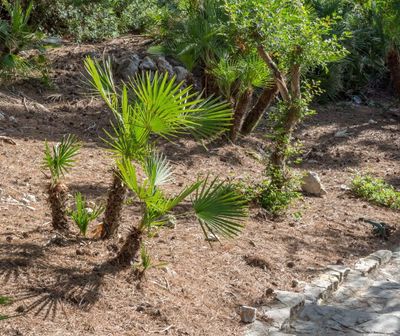Mediterranean Fan Palm Information
The Mediterranean fan palm is great in a standalone planting or can be planted with other Mediterranean fan palm plants to create a unique looking hedge or privacy screen. This palm is native to the Mediterranean, Europe, and North Africa. Leaves will be in a color palette of blue-green, gray-green, and/or yellow-green, depending on which of those regions they originate from. Here’s a fact you might want to remember if you’re ever on the game show Jeopardy: The Mediterranean fan palm is the only palm native to Europe, which is probably why this tree is also referred to as the ‘European fan palm.’ This slow growing palm can be grown outdoors in USDA hardiness zones 8 through 11. If you’re not as fortunate to live in these warmer more temperate zones, you do have the option of growing fan palm indoors in a deep container with well-draining potting soil where you can split its time indoors/outdoors. This tree is considered medium size for a palm tree with a potential height of 10 to 15 feet (3-5 m.) tall and wide. Container plantings will be more dwarfed due to restricted root growth – repot once every three years, only if needed, as the Mediterranean fan palm is said to have fragile roots. Now, let’s learn more about growing a Mediterranean fan palm.
How to Grow Mediterranean Fan Palms
So, what is involved with Mediterranean fan palm care? Growing a Mediterranean fan palm is relatively easy. Propagation is by seed or division. Best planted in a full sun to moderation shade location, the fan palm has a reputation as being very hardy, as it can endure temperatures as low as 5 degrees F. (-15 C.). Once established, they prove to be very drought resistant, although you would be advised to water it moderately, especially in the summer. Until it’s established with a deep, extensive root system (which takes a full growing season), you will want to be especially diligent in watering it. Water it weekly, and more frequently when it’s subjected to extreme heat. The Mediterranean fan palm is tolerant of a wide range of soil conditions (clay, loam, or sand texture, slightly acidic to highly alkaline soil pH), which is further testament to its hardiness. Fertilize with a slow-release palm fertilizer in spring, summer, and fall. Here’s some interesting fan palm information: Some growers will severely prune all but one trunk to ground level to make it look like a standard single trunk palm tree. However, if your goal is to have a single trunk palm, you may want to consider exploring other palm tree options. Regardless, the only pruning typically required for Mediterranean fan palm care should be to remove dead fronds.
